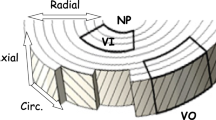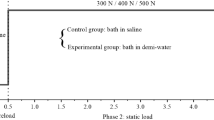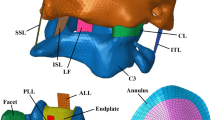Abstract
Intervertebral disks support compressive forces because of their elastic stiffness as well as the fluid pressures resulting from poroelasticity and the osmotic (swelling) effects. Analytical methods can quantify the relative contributions, but only if correct material properties are used. To identify appropriate tissue properties, an experimental study and finite element analytical simulation of poroelastic and osmotic behavior of intervertebral disks were combined to refine published values of disk and endplate properties to optimize model fit to experimental data. Experimentally, nine human intervertebral disks with adjacent hemi-vertebrae were immersed sequentially in saline baths having concentrations of 0.015, 0.15, and 1.5 M and the loss of compressive force at constant height (force relaxation) was recorded over several hours after equilibration to a 300-N compressive force. Amplitude and time constant terms in exponential force–time curve-fits for experimental and finite element analytical simulations were compared. These experiments and finite element analyses provided data dependent on poroelastic and osmotic properties of the disk tissues. The sensitivities of the model to alterations in tissue material properties were used to obtain refined values of five key material parameters. The relaxation of the force in the three bath concentrations was exponential in form, expressed as mean compressive force loss of 48.7, 55.0, and 140 N, respectively, with time constants of 1.73, 2.78, and 3.40 h. This behavior was analytically well represented by a model having poroelastic and osmotic tissue properties with published tissue properties adjusted by multiplying factors between 0.55 and 2.6. Force relaxation and time constants from the analytical simulations were most sensitive to values of fixed charge density and endplate porosity.




Similar content being viewed by others
References
Antoniou, J., T. Steffen, F. Nelson, N. Winterbottom, A. P. Hollander, R. A. Poole, M. Aebi, and M. Alini. The human lumbar intervertebral disc: evidence for changes in the biosynthesis and denaturation of the extracellular matrix with growth, maturation, ageing, and degeneration. J. Clin. Invest. 98(4):996–1003, 1996.
Ayotte, D. C., K. Ito, and S. Tepic. Direction-dependent resistance to flow in the endplate of the intervertebral disc: an ex vivo study. J. Orthop. Res. 19(6):1073–1077, 2001.
Broberg, K. B. On the mechanical behaviour of intervertebral discs. Spine 8(2):151–165, 1983.
Charnley, J. The imbibition of fluid as a cause of herniation of the nucleus pulposus. Lancet 1(6699):124–127, 1952.
Cowin, S. C. Bone poroelasticity. J. Biomech. 32(3):217–238, 1999.
Drost, M. R., P. Willems, H. Snijders, J. M. Huyghe, J. D. Janssen, and A. Huson. Confined compression of canine annulus fibrosus under chemical and mechanical loading. J. Biomech. Eng. 117(4):390–396, 1995.
Ehlers, W., N. Karajan, and B. Markert. An extended biphasic model for charged hydrated tissues with application to the intervertebral disc. Biomech. Model. Mechanobiol. 8(3):233–251, 2009.
Eisenberg, S. R., and A. J. Grodzinsky. Swelling of articular cartilage and other connective tissues: electromechanochemical forces. J. Orthop. Res. 3(2):148–159, 1985.
Elliott, D. M., and L. A. Setton. Anisotropic and inhomogeneous tensile behavior of the human anulus fibrosus: experimental measurement and material model predictions. J. Biomech. Eng. 123:256–263, 2001.
Frijns, A. J. H., J. M. Huyghe, and J. D. Janssen. A validation of the quadriphasic mixture theory for intervertebral disc tissue. Int. J. Eng. Sci. 35:1419–1429, 1997.
Fujita, Y., D. R. Wagner, A. A. Biviji, N. A. Duncan, and J. C. Lotz. Anisotropic shear behavior of the annulus fibrosus: effect of harvest site and tissue prestrain. Med. Eng. Phys. 22:349–357, 2000.
Grodzinsky, A. J., V. Roth, E. Myers, W. D. Grossman, and V. C. Mow. The significance of electromechanical and osmotic forces in the nonequilibrium swelling behavior of articular cartilage in tension. J. Biomech. Eng. 103(4):221–231, 1981.
Gu, W. Y., W. M. Lai, and V. C. Mow. A mixture theory for charged-hydrated soft tissues containing multi-electrolytes: passive transport and swelling behaviors. J. Biomech. Eng. 120:169–180, 1998.
Gu, W. Y., W. M. Lai, and V. C. Mow. Transport of fluid and ions through a porous-permeable charged-hydrated tissue, and streaming potential data on normal bovine articular cartilage. J. Biomech. 26(6):709–723, 1993.
Gu, W. Y., V. C. Mao, R. J. Foster, M. Weidenbaum, V. C. Mow, and B. A. Rawlins. The anisotropic hydraulic permeability of human lumbar anulus fibrosus. Influence of age, degeneration, direction, and water content. Spine 24(23):2449–2455, 1999.
Hendry, N. G. C. The hydration of the nucleus pulposus and its relation to intervertebral disc derangement. J. Bone Joint Surg. 40B(1):132–144, 1958.
Heneghan, P., and P. E. Riches. Determination of the strain-dependent hydraulic permeability of the compressed bovine nucleus pulposus. J. Biomech. 41(4):903–906, 2008.
Holzapfel, G. A., C. A. Schulze-Bauer, G. Feigl, and P. Regitnig. Single lamellar mechanics of the human lumbar anulus fibrosus. Biomech. Model. Mechanobiol. 3(3):125–140, 2005.
Huyghe, J. M., and M. R. Drost. Uniaxial tensile testing of canine annulus fibrosus tissue under changing salt concentrations. Biorheology 41(3–4):255–261, 2004.
Huyghe, J. M., G. B. Houben, M. R. Drost, and C. C. van Donkelaar. An ionised/non-ionised dual porosity model of intervertebral disc tissue. Biomech. Model. Mechanobiol. 2(1):3–19, 2003.
Huyghe, J. M., and J. D. Janssen. Quadriphasic mechanics of swelling incompressible porous media. Int. J. Eng. Sci. 35(8):793–802, 1997.
Iatridis, J. C., J. P. Laible, and M. H. Krag. Influence of fixed charge density magnitude and distribution on the intervertebral disc: applications of a poroelastic and chemical electric (PEACE) model. J. Biomech. Eng. 125:12–24, 2003.
Iatridis, J. C., J. J. MacLean, M. O’Brien, and I. A. Stokes. Measurements of proteoglycan and water content distribution in human lumbar intervertebral discs. Spine 32(14):1493–1497, 2007.
Iatridis, J. C., L. A. Setton, M. Weidenbaum, and V. C. Mow. Alterations in the mechanical behavior of the human lumbar nucleus pulposus with degeneration and aging. J. Orthop. Res. 15(2):318–322, 1997.
Johannessen, W., and D. M. Elliott. Effects of degeneration on the biphasic material properties of human nucleus pulposus in confined compression. Spine 30(24):E724–E729, 2005.
Johannessen, W., E. J. Vresilovic, A. C. Wright, and D. M. Elliott. Intervertebral disc mechanics are restored following cyclic loading and unloaded recovery. Ann. Biomed. Eng. 32(1):70–76, 2004.
Lai, W. M., J. S. Hou, and V. C. Mow. A triphasic theory for the swelling and deformation behaviors of articular cartilage. J. Biomech. Eng. 113(3):245–258, 1991.
Laible, J. P., D. S. Pflaster, M. H. Krag, B. R. Simon, and L. D. Haugh. A poroelastic-swelling finite element model with application to the intervertebral disc. Spine 18(5):659–670, 1993.
Laible, J. P., D. Pflaster, B. R. Simon, M. H. Krag, M. Pope, and L. D. Haugh. A dynamic material parameter estimation procedure for soft tissue using a poroelastic finite element model. J. Biomech. Eng. 116(1):19–29, 1994.
Li, G. P., J. T. Bronk, K. N. An, and P. J. Kelly. Permeability of cortical bone of canine tibiae. Microvasc. Res. 34(3):302–310, 1987.
Lim, T. H., and J. H. Hong. Poroelastic properties of bovine vertebral trabecular bone. J. Orthop. Res. 18(4):671–677, 2000.
Malko, J. A., W. C. Hutton, and W. A. Fajman. An in vivo MRI study of the changes in volume (and fluid content) of the lumbar intervertebral disc after overnight bed rest and during an 8-hour walking protocol. J. Spinal Disord. Tech. 15(2):157–163, 2002.
Mcmillan, D. W., G. Garbutt, and M. A. Adams. Effect of sustained loading on the water content of intervertebral discs: Implications for disc metabolism. Ann. Rheum. Dis. 55(12):880–887, 1996.
Mow, V. C., S. C. Kuei, W. M. Lai, and C. G. Armstrong. Biphasic creep and stress relaxation of articular cartilage in compression: theory and experiments. J. Biomech. Eng. 102(1):73–84, 1980.
Natarajan, R. N., S. A. Lavender, H. A. An, and G. B. Andersson. Biomechanical response of a lumbar intervertebral disc to manual lifting activities: a poroelastic finite element model study. Spine 33(18):1958–1965, 2008.
Natarajan, R. N., J. R. Williams, and G. B. Andersson. Recent advances in analytical modeling of lumbar disc degeneration. Spine 29(23):2733–2741, 2004.
Perié, D., D. Korda, and J. C. Iatridis. Confined compression experiments on bovine nucleus pulposus and annulus fibrosus: sensitivity of the experiment in the determination of compressive modulus and hydraulic permeability. J. Biomech. 38(11):2164–2171, 2005.
Riches, P. E., N. Dhillon, J. Lotz, A. W. Woods, and D. S. McNally. The internal mechanics of the intervertebral disc under cyclic loading. J. Biomech. 35:1263–1271, 2002.
Roughley, P. J. Biology of intervertebral disc aging and degeneration: involvement of the extracellular matrix. Spine 29(23):2691–2699, 2004.
Schroeder, Y., D. M. Elliott, W. Wilson, F. P. Baaijens, and J. M. Huyghe. Experimental and model determination of human intervertebral disc osmoviscoelasticity. J. Orthop. Res. 26(8):1141–1146, 2008.
Setton, L. A., W. Zhu, M. Weidenbaum, A. Ratcliffe, and V. C. Mow. Compressive properties of the cartilaginous end-plate of the baboon lumbar spine. J. Orthop. Res. 11(2):228–239, 1993.
Simon, B. R., J. P. Liable, D. Pflaster, Y. Yuan, and M. H. Krag. A poroelastic finite element formulation including transport and swelling in soft tissue structures. J. Biomech. Eng. 118(1):1–9, 1996.
Simon, B. R., J. S. Wu, M. W. Carlton, J. H. Evans, and L. E. Kazarian. Structural models for human spinal motion segments based on a poroelastic view of the intervertebral disk. J. Biomech. Eng. 107(4):327–335, 1985.
Simon, B. R., J. S. Wu, M. W. Carlton, L. E. Kazarian, E. P. France, J. H. Evans, and O. C. Zienkiewicz. Poroelastic dynamic structural models of rhesus spinal motion segments. Spine 10(6):494–507, 1985.
Stokes, I. A., M. Gardner-Morse, D. Churchill, and J. P. Laible. Measurement of a spinal motion segment stiffness matrix. J. Biomech. 35(4):517–521, 2002.
Thompson, J. P., R. H. Pearce, M. T. Schechter, M. E. Adams, I. K. Tsang, and P. B. Bishop. Preliminary evaluation of a scheme for grading the gross morphology of the human intervertebral disc. Spine 15(5):411–415, 1990.
Urban, J. P., and A. Maroudas. Swelling of the intervertebral disc in vitro. Connect. Tissue Res. 9(1):1–10, 1981.
Urban, J. P., and J. F. Mcmullin. Swelling pressure of the intervertebral disc: influence of proteoglycan and collagen contents. Biorheology 22(2):145–157, 1985.
van der Veen, A. J., M. G. Mullender, I. Kingma, J. H. van Dieen, and T. H. Smit. Contribution of vertebral bodies endplates and intervertebral discs to the compression creep of spinal motion segments. J. Biomech. 41(6):1260–1268, 2008.
van Loon, R., J. M. Huyghe, M. W. Wijlaars, and F. P. T. Baaijens. 3D FE implementation of an incompressible quadriphasic mixture model. Int. J. Numer. Methods Eng. 57:1243–1258, 2003.
Wilson, W., C. C. van Donkelaarm, and J. M. Huyghe. A comparison between mechano-electrochemical and biphasic swelling theories for soft hydrated tissues. J. Biomech. Eng. 127(1):158–165, 2005.
Yao, H., and W. Y. Gu. Three-dimensional inhomogeneous triphasic finite-element analysis of physical signals and solute transport in human intervertebral disc under axial compression. J. Biomech. 40(9):2071–2077, 2007.
Acknowledgments
This study was funded by NIH Grant R01 AR 049370. Lumbar spines were provided by the National Disease Research Interchange (NDRI). Jacob Lubinski assisted with a preliminary study. Richard Stanley provided technical support for experimental work.
Author information
Authors and Affiliations
Corresponding author
Additional information
Associate Editor Peter E. McHugh oversaw the review of this article.
Rights and permissions
About this article
Cite this article
Stokes, I.A.F., Laible, J.P., Gardner-Morse, M.G. et al. Refinement of Elastic, Poroelastic, and Osmotic Tissue Properties of Intervertebral Disks to Analyze Behavior in Compression. Ann Biomed Eng 39, 122–131 (2011). https://doi.org/10.1007/s10439-010-0140-1
Received:
Accepted:
Published:
Issue Date:
DOI: https://doi.org/10.1007/s10439-010-0140-1




